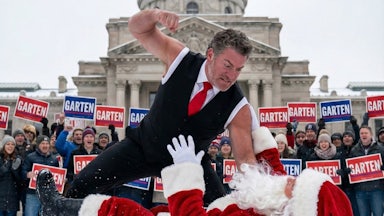On Thursday, the U.S. (golf) Open began as the Justice Department mulled a pending merger between the PGA Tour and LIV Golf, which is owned by Saudi Arabia’s sovereign wealth fund. Great wealth, as it happens, is also a theme of this year’s U.S. Open, and not just because of the Saudis. That’s because it’s being staged on the most expensive piece of undeveloped and privately owned land in the United States. The venue is, Sam Farmer wrote June 11 in the Los Angeles Times, “the greatest course people have never seen.” Especially certain sorts of people.
If you grew up on the West Side of Los Angeles and were Jewish, African American, or a woman, you knew all about the Los Angeles Country Club. It was founded in 1897, before there was a West Los Angeles (or even much of a Los Angeles), and it relocated to its present site in 1911 as part of the adjacent area’s evolution from a lima bean field with a few oil wells into a housing development (later a small city) called Beverly Hills. The country club is freaking enormous: 313 acres of manicured greenery situated in a residential neighborhood now overrun with millionaires. (A typical golf course is less than half that size.)
From the start, the L.A. Country Club limited its membership to Christian white males. That wasn’t particularly unusual in 1911. But it certainly was by the time the club finally started easing up on that rule—in the late 1970s. The first two Jews were admitted in 1977, the first African American in 1991. Until quite recently, the club also refused to admit show people, who started displacing oilmen as the West Side’s propertied class in the 1910s. That prompted male Jewish golfers in the entertainment industry to create Hillcrest Country Club around 1920.
It shouldn’t make economic sense for the L.A. Country Club to still exist, given what you’d expect it to pay in property taxes—it’s less than a mile down Wilshire Boulevard from downtown Beverly Hills. Property tax appraisals are calculated based on something called “the highest and best use,” meaning that use which yields the greatest monetary benefit given the size and location of the property. The highest and best use of 313 acres straddling Beverly Hills (median home sale: $3.6 million) and Holmby Hills (median home sale: $5.7 million) is pretty obviously not a golf course. Not even a golf course that costs a king’s ransom to join; according to the online sports newspaper Diario AS, initiation fees range from $300,000 to $500,000, and annual dues from $20,000 to $30,000.
Nobody really knows how much the land the L.A. Country Club sits atop is worth, because you can’t identify any of what a realtor would call “comparables.” But Malcolm Gladwell has suggested $9 billion, which, according to the L.A. Weekly, means the L.A. Country Club should be paying $60 to $90 million each year in property taxes. Instead, it pays about $300,000, according to an article posted Thursday by Ben Orbison on Defector. Aficionados of the celebrated nineteenth-century American reformer* Henry George (“tax land, not improvements”) will recognize this as that great man’s worst nightmare.
How did it happen? Blame Bob Hope. (What, you don’t know who Bob Hope was? Here.) In 1960, Hope, an avid golfer, campaigned enthusiastically for California’s Proposition 6, which wrote into the state’s constitution that a golf course could no longer be assessed based on its highest and best use. Instead, assessors were permitted to consider only the land’s use as a golf course.
“How would you like,” warned a letter in support of the measure signed by Hope’s wife, Dolores,
the golf courses nearest your home to be converted into noisy factory layouts, clamorous supermarkets, traffic-jammed shopping centers, or brick-and-mortar apartment units? Proposition 6 is designed to save these courses and their benefits to you and your family as wooded, planted, open space areas giving greenbelt breathing space to California’s growing cities.
The measure passed 62–38 percent.
Prop 6 radically lowered taxes for L.A. Country Club and other golf courses across the state. It was later bolstered in 1978 by Prop 13, the property-tax-limiting measure that created a national tax revolt that pretty much never ended.
In 1971, two Jewish California taxpayers challenged what by then was known as the Bob Hope Exemption in court, on the highly persuasive grounds that discriminatory organizations did not merit a tax subsidy. The court rejected this argument, Orbison reports, citing Mrs. Hope’s nonsense about “wooded, planted, open space areas giving greenbelt breathing space to California’s growing cities.” Never mind that this breathing space was denied to women, Jews, Blacks, and anyone lacking $300,000 for the initiation fee.
Now, at least, Americans can glimpse this Shangri-La on their TVs. That’s a start. The next step should be an eminent-domain seizure of the club by Los Angeles County so it can be turned into a public park. If the public is going to pay for this greenbelt, it should be allowed to use it without shelling out hundreds of thousands of dollars.
* An earlier version of this article referred to George erroneously as a socialist. Although he was a strong influence on socialist thinking, especially in Britain, he did not consider himself one.






